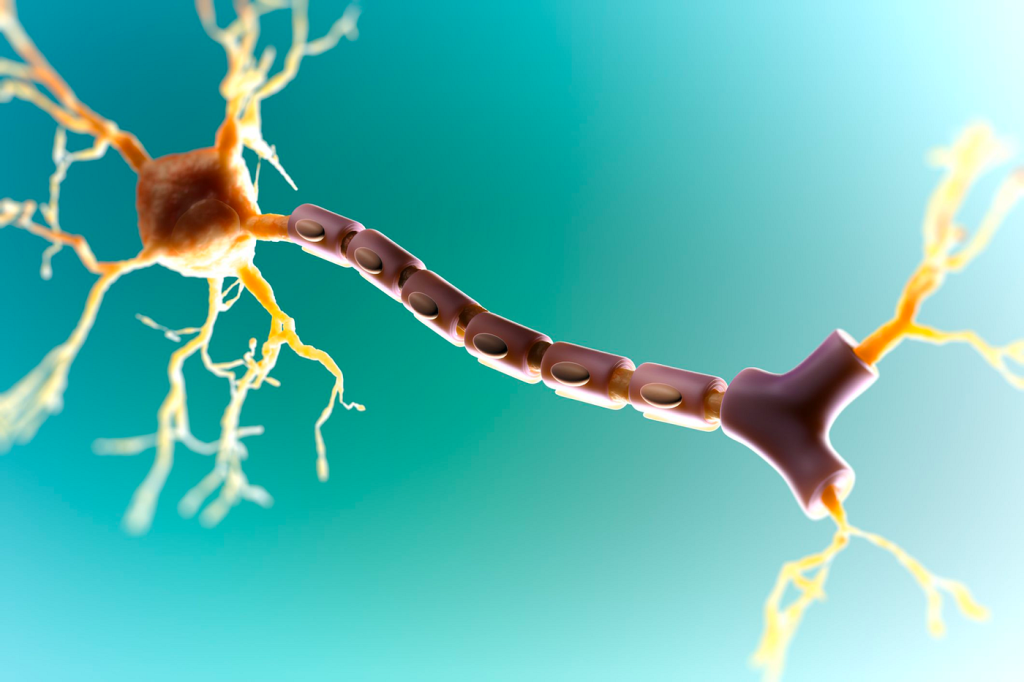
What is Myelin?
Think about the structure of an electrical cord. The electrical wire is covered by a rubber or plastic coating which insulates the wire. A similar comparison can be made to the electrical “wires’’ of our nervous system. Neurons are the cells that conduct the signals being sent from the brain, which travel down the cell’s axon (or “wire”), allowing the electrical impulse to be transmitted from one cell to another.
Myelin (pronounced ˈmī-ə-lən), is a fatty substance produced by cells in our central and peripheral nervous systems that provides a coating or sheath around the axons. Myelin acts as an insulator, similar to the rubber or plastic of a cord. Not only does the myelin protect the axons, it also allows for the quick and efficient transmission of the electrical signal. Therefore, impulses carried in myelinated axons travel quickly from the body to the brain and from the brain to the body.
In other words, myelin is essential for maintaining healthy function within your nervous system. When myelin sheaths are damaged, your nerves can’t transmit messages as they should. For the motor system this means the neurons carrying the messages for movement may be impacted, resulting in limited or impaired mobility.
Myelin and Multiple Sclerosis
Multiple sclerosis (MS) is an immune-mediated disease in which the body mistakenly attacks oligodendrocytes, the cells that produce myelin in the central nervous system. An MS attack can create an inflammatory response that results in damage to both oligodendrocytes and the myelin sheath which can significantly impact nerve conduction. This can subsequently result in weakened muscles, decreased coordination, and impaired motor control.
Repair of the myelin sheath, or remyelination, can occur in MS, but with repeated attacks, oligodendrocytes are destroyed and unmyelinated axons are susceptible to irreparable damage.
How Can You Rebuild Myelin?
Much of the current treatment for MS focuses on slowing the progression of the disease by suppressing the immune system and controlling inflammation through medications. But what if disease progression could be reversed? What if you could rebuild myelin? What if this could be achieved without medication?
It is well known that exercise has positive effects on muscles, the heart, lungs, and many other tissues in the body. And now, recent animal studies have shown that exercise, through a variety of mechanisms, can also promote rebuilding myelin. Thus, by increasing physical activity not only could neurodegeneration be slowed or halted, but strength, coordination, and motor control could be restored.
The Cionic Neural Sleeve — From Assistive Device to Therapeutic
Since mobility is often impacted in individuals with MS, exercise can pose a challenge. There is the physical component of moving in a body that doesn’t always perform the way one wills it to, and the cognitive demand of having to think about each individual movement.
The Cionic Neural Sleeve allows our users with MS to move more efficiently and confidently and with less cognitive demand. This leads to increased activity levels and the ability to walk for significantly longer periods of time. Jim Vecchi is one of our users living with MS and he had this to say: “The other day I went for a walk wearing the Neural Sleeve and it was helping me, and I realized afterwards that the whole time I was walking I was thinking about something else completely. How many times have I been able to do that over the last couple of years?”
If exercise results in the production of myelin, and the Cionic Neural Sleeve allows individuals with MS to increase their exercise capacity, then the Cionic Neural Sleeve has the potential to reverse the disease process. This is exciting because it means that the Cionic Neural Sleeve has the potential to be not only an assistive technology to help retain mobility, but also a therapeutic to actually regain mobility. More research is needed, but we are encouraged by the early studies linking remyelination to physical fitness and hope that we can support that process with improved mobility for people living with MS.





